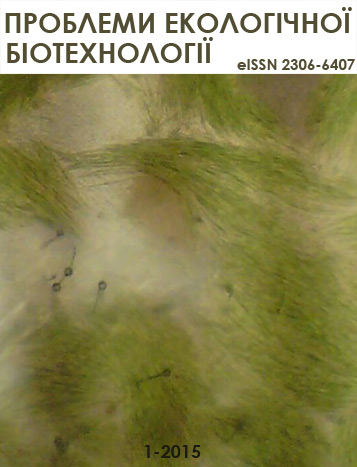Порівняльний аналіз джерел отримання хітозану
DOI:
https://doi.org/10.18372/2306-6407.1.8522Ключові слова:
хітин, хітозан, морські організми, гриби, мікроорганізми, комахиАнотація
У статті висвітлено властивості та області застосування таких біополімерів як хітин і хітозан. Розглянуто традиційні джерела отримання хітозану та проблеми, які виникають за їх використання. Запропоновано альтернативні, більш перспективні джерела отримання хітозану.Посилання
Se-Kwon Kim Chitin, сhitosan, oligosaccharides and their derivatives / Se-Kwon Kim. – United States of America: Taylor and Francis Group, 1989. – 633 p.
Chitin of insects, spiders, lobsters, shrimp. − [Electronic resource]. − Access: http://academic.brooklyn.cuny.edu/biology/bio4fv/page/chitin.html
Гальбрайх Л. С. Хітин і хітозан: будова, властивості, застосування / Л. С. Гальбрайх // Соровский освітній журнал. − 2001. − № 1. − С. 51−56.
Бикова В. М. Сировинні джерела і способи отримання хітину та хітозану: Хітин, його будова і властивості / В. М. Бикова, С. В. Німців. − М.: Наука, 2002. − 170 c.
Raw materials for medical application. − [Electronic resource]. − Access: http://www.altakitin.com/?Products
Маслов Г. В. Вплив виду сировини що містить хітин на фізико-хімічні властивості хітинових біополімерів, отриманих за допомогою електрохімічно активованих речовин // Матеріали шостої міжнародної конференції “Нові досягнення в дослідженні хітину та хітозану” − Москва: ВНІРО, 2001. − C. 35−38.
Медицинская информация о хитозане. − [Електронний ресурс]. − Режим доступу: http://medicinform.net/product/xenical/chitosan.htm
Бджоли і мертвими корисні людству.− [Електронний ресурс].− Режим доступу: http://www.medolub.kiev.ua/pidmor.html
Chitin and chitosan value-added products from mushroom wastes / [Wu T., Zivanovic S., Draughon F. A., Sams C. E] // European journal of pharmaceutics and biopharmaceutics. − 2009. − № 67. − P. 552−560.
Chitin and chitosan in comprehensive glycoscience / [Boons G., Lee Y., Suzuki A. et al.]; ed. by H. Kamerling. – Amsterdam: Science of chemistry, 2007. − 670 p.
Crestini C. Production and isolation of chitosan by submerged and solid state fermentation from Lentinus edodes / Crestini C., Kovac B., Giovannozzi-Sermanni G. // Biotechnology and bioengineering. − 1996. − № 50. − P. 207–210.
Nwe N. Production of chitin and chitosan and their applications in the medical and biological sector / N. Nwe, W. Stevens // Recent research in biomedical aspects of chitin and chitosan. − 2008. − № 27. − P. 161–176.
Shahidi F. Isolation and characterization of nutrients and value-added products from snow crab (Chionoecetes opilio) and shrimp (Pandalus borealis) processing discards / F. Shahidi, J. Synowiecki // Recent research in products from snow crab. − 1991. − № 17. − P. 1527–1532.
Fernandez-Kim S. O. Physiochemical and functional properties of crawfish chitosan as affected by different processing protocols / S. O. Fernandez-Kim. − Louisiana: State University, 2004. – 456 p.
Effect of medium components and time of cultivation on chitin production by Mucor circinelloides / [Andrade V.S., Neto B. B., Fukushima K., Campos-Takaki G.M.].− Canada: A factorial study, 2003. –543 p.
Chitin: new facets of research / [Austin P. R., Brine C. J., Castle J. E., Zikakis J. P.]. − Canada: Science, 1981.− 945 p.
Johnson E.L. Utilization of shellfish waste for chitin and chitosan production / E. L. Johnson, Q. P. Peniston // Chemistry & biochemistry of marine food products. – 1982. − № 23. − P. 514–522.
Highly deacetylated chitosan and its properties / [Mima S., Miya M., Iwamoto R., Yoshikawa S.].− Canada: Applied polymer, 1983.− 1917 p.
Shimahara K. Preparation of crustacean chitin / K. Shimahara, Y. Takiguchi // Methods of enzymology. – 1988. − № 46. − P. 417−423.
Arcidiacono S. Fermentation, processing and enzyme characterization for chitosan biosynthesis by Mucor rouxii / Arcidiacono S., Lombardi S. J., Kaplan D. L. // Chitin and chitosan: sources, chemistry, biochemistry, physical properties and applications. − 1989. − № 19. − P. 319–332.
Antimicrobial activity of shrimp chitin and chitosan from different treatments and applications of fish preservation / [Tsai G. T., Su W. H., Chen H. C., Pan C. L. ]. – California: Health, 1990. – 478 p.
Production and distribution of endoglucanase, cellobiohydrolase, and beta -glucosidase components of the cellulolytic system of volvariella volvacea, the edible straw mushroom / Cai Y. J., Chapman S. J., Buswell J. A., Chang S. // Applied microbiology and biotechnology.− 1999. − № 30. − P. 553−559.
Chitosan from absidia coerulea / [Muzzarelli R. A., Ilari P., Tarsi R. et al]. − England: Carbohydrate polymers, 1994. − 76 p.
Chitin and chitosan from basidiomycetes / [Mario F. D, Rapana P., Tomati U., Galli E.] // International journal of biological macromolecules.− 2008. − № 46. – P. 8–12.
Pochanavanich P. Fungal chitosan production and its characterization / P. Pochanavanich, W. Suntornsuk // Letters in applied microbiology. − 2002. − № 19. – P. 17–21.
Isolation of the chitin-glucan complex from the fruiting bodies of mycothallus / [Ivshina T. N., Artamonova S. D., Ivshin V. P., Sharnina F. F.]. – Canada: Human body complex, 2009 −588 p.
Vasylchenko О. А. Dead bees as alternative sources for chitosan obtaining / О. А. Vasylchenko, М. V. Аbramova // Матеріали ХIІ міжн. наук.-техн. конф. «Авіа-2015», Київ: НАУ, 2015. – C. 27.5-27.8.29.
Concurrent production of chitin from shrimp shells and fungi / [Teng W. L., Khor E., Tan T. K. et al.]. – Moscow: Science, 2001 – 675 p.


